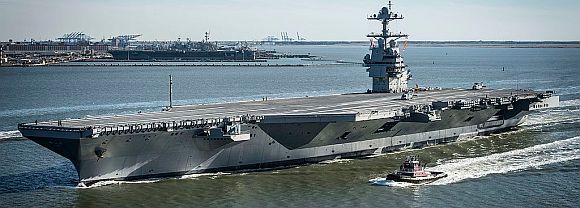 The $13 billion dollar aircraft carrier USS Gerald R. Ford is the most expensive warship the world has ever seen. Commissioned in 2017, the ship is still not ready for deployment. Is the Ford almost ready for combat service or is it still what critics have called a $13 billion berthing barge? It all depends on who you ask — the Navy or the General Accounting Office (GAO).
The $13 billion dollar aircraft carrier USS Gerald R. Ford is the most expensive warship the world has ever seen. Commissioned in 2017, the ship is still not ready for deployment. Is the Ford almost ready for combat service or is it still what critics have called a $13 billion berthing barge? It all depends on who you ask — the Navy or the General Accounting Office (GAO).
According to the Navy, things are going well. The National Interest reports that the USS Gerald R. Ford (CVN 78) recently completed the tests to prove that the latest aircraft carrier to enter service can launch and recover jets. Now the U.S. Navy has announced that it has the largest air wing embark to date. In addition, the Ford completed its first ordnance movement from a lower deck magazine to the carrier’s F/A-18E Super Hornets using the ship’s state-of-the-art Advanced Weapons Elevators.
A GAO Report issued at roughly the same time as the Navy announcement has a somewhat different view.
The report concludes that “the Navy is still struggling to demonstrate the reliability of key systems.” Currently, only five of the eleven Advanced Weapons Elevators actually work. According to the report, “none of the elevators that operate between the main deck and the lower decks are currently operational, which means the elevators are still not capable of bringing munitions to the flight deck.”
The Navy is working to complete all elevator work by spring 2021, according to the GAO, an 18-month delay from the schedule the agency reported in 2019.
Task and Purpose reports that the advanced weapons elevators aren’t the only critical systems facing major issues: According to the report, the electromagnetic aircraft launch system (EMALS) and Advanced Arresting Gear (AAG) that make up the Ford’s next-generation aircraft launch and retrieval capabilities are still deeply unreliable.
“Although the Navy is testing EMALS and AAG on the ship with aircraft, the reliability of those systems remains a concern,” the GAO report says. “If these systems cannot function safely by the time operational testing begins, CVN 78 will not be able to demonstrate it can rapidly deploy aircraft—a key requirement for these carriers.”
There are also problems with the Dual Band Radar (DBR) which will be replaced in later carriers of the class.
And then there is a problem with the toilets. The toilets and the entire sewage system tends to get easily clogged. When this happens, the Navy has to flush the system with acid to clear it at a reported cost of $400,000. How often does this happen? The GAO says that the Navy cannot say.
It is likely that both sides are at least partially right. The Navy is accurate in saying that the ship may be getting closer to being ready, while the GAO is right in that there are still challenges ahead.
Construction on the USS Ford began in 2005. The ship may not be ready to deploy until 2024. The GAO report notes that “continuing technical deficiencies mean the Navy may still require more funding to complete this ship.”

Well, she looks good, and looking good is half the battle won in yachting.
And just now– a yacht, as evidenced by the classic yacht summary: “…struggling to demonstrate the reliability of key systems.”
The way it works on a new construction vessel the US Navy ‘buys’ a space, a system that crosses multiple spaces (like the elevators), or a component made of multiple systems such as a reactor; from the shipyard when the Navy deems them to be operational given the design specs and finished with things such as painting (and cleaned), signage installed, etc..
The shipyard crosses that item off its list and moves on to another item on its final approval checklist and sends the Navy a bill under the intitial contract for that space/system/component. The issues being reported belong to the Navy as they signed off on the carrier in total, even with the known elevator issues and the sanitary system stoppages. Now any work on the ship by General Dynamics or Raytheon for the DBR costs the Navy more money. These are being incorrectly reported as cost over runs by the shipyard, they are not. They are bad purchases by NAVSEA, who has a history of rushing new and highly complex systems into full blown production without bothering to completely test them; aided by GDs whose an expert in covering issues up to get the ship out the door.
A great book on these issues is Running Critical: The Silent War, Rickover, and General Dynamics. It is about subs, but same principles apply.